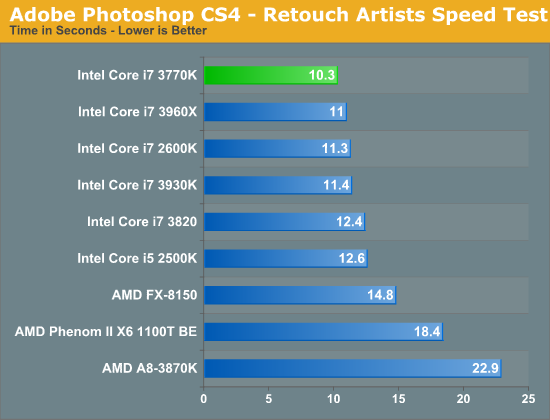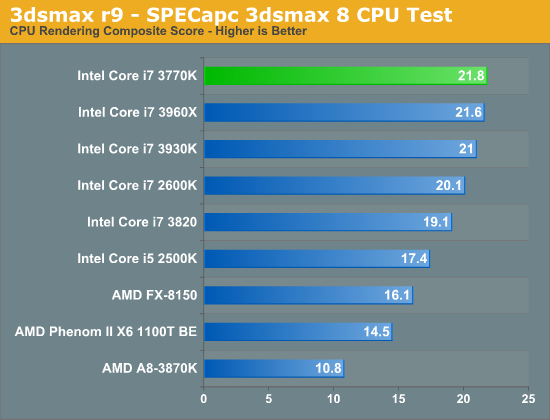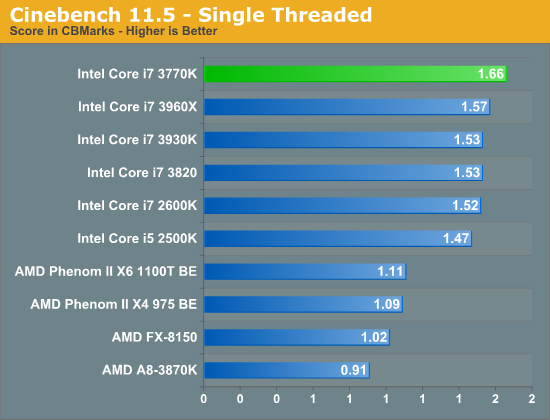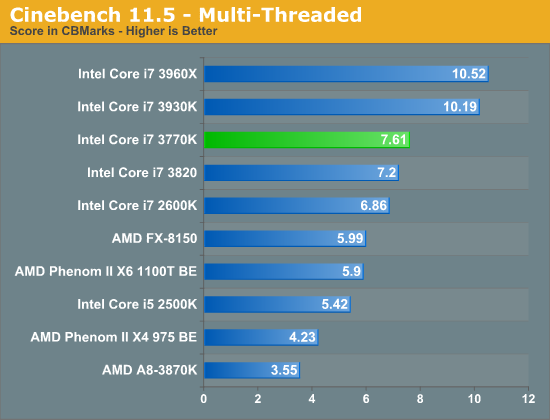The Ivy Bridge Preview: Core i7 3770K Tested
by Anand Lal Shimpi on March 6, 2012 8:16 PM EST- Posted in
- CPUs
- Intel
- Core i7
- Ivy Bridge
Content Creation Performance
Adobe Photoshop CS4
To measure performance under Photoshop CS4 we turn to the Retouch Artists’ Speed Test. The test does basic photo editing; there are a couple of color space conversions, many layer creations, color curve adjustment, image and canvas size adjustment, unsharp mask, and finally a gaussian blur performed on the entire image.
The whole process is timed and thanks to the use of Intel's X25-M SSD as our test bed hard drive, performance is far more predictable than back when we used to test on mechanical disks.
Time is reported in seconds and the lower numbers mean better performance. The test is multithreaded and can hit all four cores in a quad-core machine.

Our Photoshop test is well threaded but it doesn't peg all cores constantly. Instead you get burstier behavior. With the core count advantage out of the way, SNB-E steps aside and allows the 3770K to step up as the fastest CPU we've tested here. The performance advantage over the 2600K is around 9%.
3dsmax 9
Today's desktop processors are more than fast enough to do professional level 3D rendering at home. To look at performance under 3dsmax we ran the SPECapc 3dsmax 8 benchmark (only the CPU rendering tests) under 3dsmax 9 SP1. The results reported are the rendering composite scores.

In another FP heavy workload we see a pretty reasonable gain for Ivy Bridge: 8.5% over a 2600K. This isn't enough to make you want to abandon your Sandy Bridge, but it's a good step forward for a tick.
Cinebench 11.5
Created by the Cinema 4D folks we have Cinebench, a popular 3D rendering benchmark that gives us both single and multi-threaded 3D rendering results.

The single threaded Cinebench test shows a 9% performance advantage for the 3770K over the 2600K. The gap increases slightly to 11% as we look at the multithreaded results:

If you're running a workload that can really stress multiple cores, the 6-core Sandy Bridge E parts will remain unstoppable but in the quad-core world, Ivy Bridge leads the pack.










195 Comments
View All Comments
taltamir - Monday, March 12, 2012 - link
Rarson is correct.He isn't suggesting no IGP at all. He is saying put a good IGP on the lower end.
While there ARE people who need a powerful CPU and will not get a video card because they don't play games, those people do not in any way benefit from having a higher end IGP.
High end gamers = discreete GPU + Powerful CPU
Budget gamers = IGP + mid-low range CPU
Non gamers with money = High end CPU + IGP (underused)
Non gamers on a budget = Mid-low range CPU + IGP (underused)
The only people who need a more powerful GPU are the budget gamers and thus it makes sense on the lower end CPUs to have a more powerful IGP.
Urillusion17 - Monday, March 12, 2012 - link
Great article but.... where are the temps??? The few benches I have seen don't mention overclocking, and if they do, they do not mention temps. I am hearing this chip can boil water! I would think that would be as important as anything else...DrWattsOn - Tuesday, March 13, 2012 - link
+1 (very much in agreement)boogerlad - Wednesday, March 14, 2012 - link
is it possible to fully load the igp with an opencl application, and not affect the cpu performance at all? From what I've read, it appears the igp shares the cache with the cpu, so will that affect performance?rocker123 - Monday, March 19, 2012 - link
Generational performance improvements on the CPU side generally fall in the 20 - 40% range. As you've just seen, Ivy Bridge offers a 7 - 15% increase in CPU performance over Sandy Bridge - making it a bonafide tick from a CPU perspectiveShould be :Generational performance improvements on the GPU side generally fall in the 20 - 40% range
rocker123 - Monday, March 19, 2012 - link
Generational performance improvements on the CPU side generally fall in the 20 - 40% range. As you've just seen, Ivy Bridge offers a 7 - 15% increase in CPU performance over Sandy Bridge - making it a bonafide tick from a CPU perspectiveShould be :Generational performance improvements on the GPU side generally fall in the 20 - 40% range
tipoo - Monday, March 19, 2012 - link
They give the drivers their own tweaks and bug fixes, but I doubt they could do something like add T&L without the manufacturers support. In fact, they didn't, unless they have bigger driver teams now.ClagMaster - Wednesday, March 21, 2012 - link
"Personally, I want more and I suspect that Haswell will deliver much of that. It is worth pointing out that Intel is progressing at a faster rate than the discrete GPU industry at this point. Admittedly the gap is downright huge, but from what I've heard even the significant gains we're seeing here with Ivy will pale in comparison to what Haswell provides."Personally, I believe on-board graphics will never be on par with a dedicated graphics part. And it is obcessive-compulsive ridiculous to compare the performance of the HD4000 with discrete graphics and complain its not as good.
The HD4000 is meant for providing graphics for business and multi-media computers. And for that purpose it is outstanding.
If you want gaming or engineering workstation performance, get a discrete graphics card. And stop angsting about how bad onboard graphics is to discrete graphics.
pottermd - Thursday, March 22, 2012 - link
Today's desktop processors are more than fast enough to do professional level 3D rendering at home.The article contained this statement. It's not really true. I've had a long nap and the render I'm doing is still running. :)
Dracusis - Friday, April 6, 2012 - link
"The people who need integrated graphics"No one *needs* integrated graphics. But not everyone needs discrete graphics. The higher performance an IGP has, the less people overall will *need* DGPs.
Not all games need dedicated graphics cards, just the multi million dollar re-hashed COD's that choke retail stores. There are literally thousands of other games around that only require a small amount of graphics processing power. Flash now has 3D accelerated content and almost every developer using it will target IGP performance levels. Almost all casual game developers target IGPs as well, they're not selling to COD players. Sure, most of those games won't need a hight end CPU as well, but people don't buy computers to play casual games, they buy them for a massive range of tasks, the vast majority of which will be CPU bound so faster would be better.
Also, as an indie game developer I hit performance walls with CPUs more often than I do with GPUs. You can always scale back geometry/triangle counts, trim or cut certain visual effects but cutting back on CPU related overheads generally means you're cutting out gameplay.